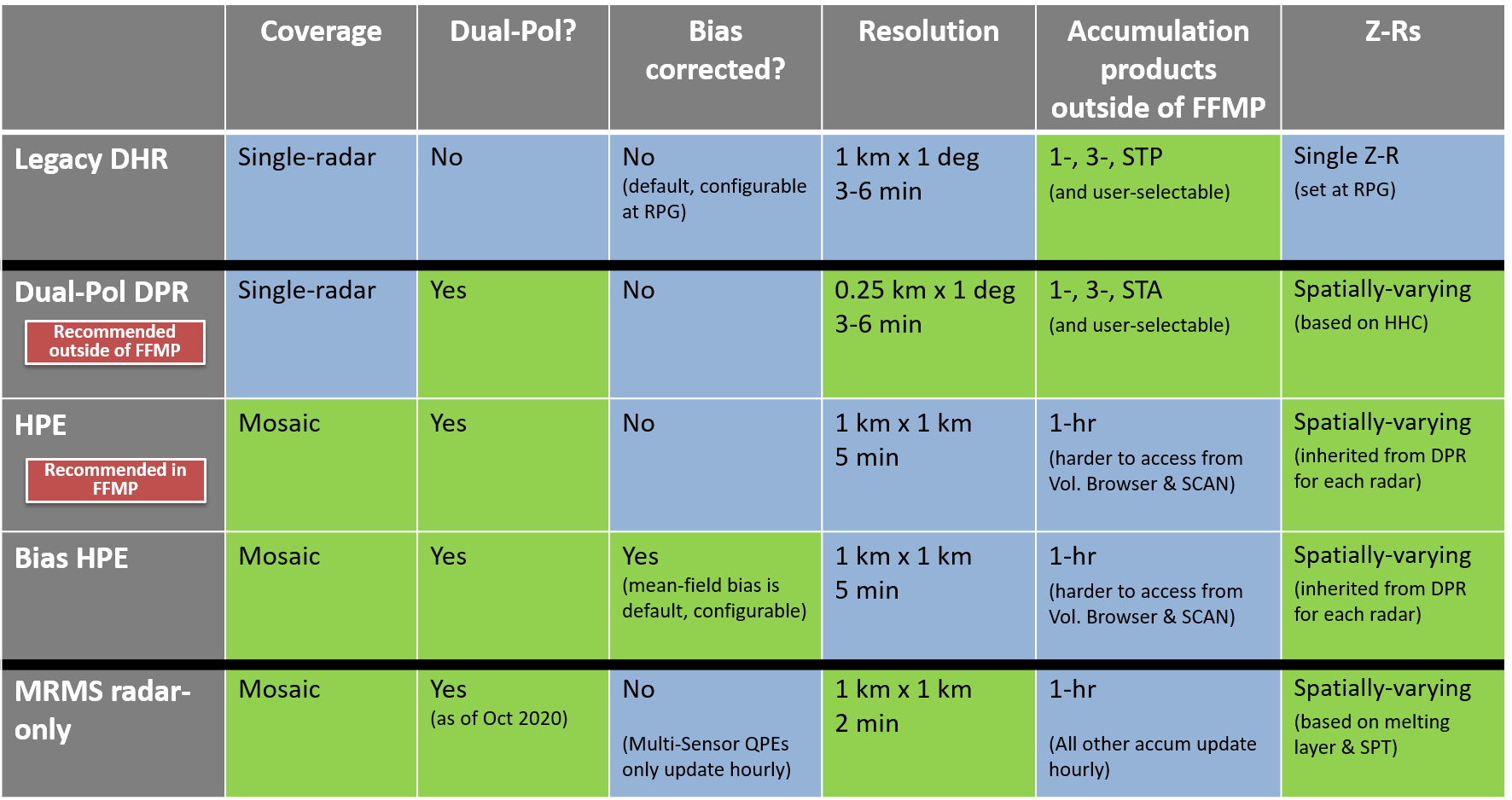FFMP - OCLO
FFMP
FFMP Usage Page
Last updated: December 2020
FFMP Precip Sources:
- DHR (Digital Hybrid Reflectivity) - "Legacy" based single radar
- DPR (Digital Precipitation Rate) - Dual Pol single radar
- HPE (High-Resolution Precipitation Estimator) - Mosaic that is DPR-based by default but can be configured to be DHR locally
- Bias HPE - Mosaic of HPE that has been bias corrected with mean field biases for each radar
- Talk to your Hydro Focal Point, but many offices are not receiving mean-field biases from the RFCs. Therefore, your default bias information is coming from your local MPE. Please contact Mike Magsig to learn how to set up the RFC ingest.
- MRMS (Multi-Radar Multi-Sensor) - Mosaic that is based on MRMS Surface Precipitation Rate (SPR)
Here is the table that summarizes the characteristics of each precip source (last updated Dec 2020):

Table Notes:
- Bias HPE bugs
- Bias HPE has several bugs related to the ingest and display of data. WDTD recommends only using Bias HPE on a case-by-case basis only if the biases look reasonable with local gauge comparison. Please take the training "HPE and Bias HPE" to learn more about these issues.
FFMP Usage Tips
- The MRMS mosaic and the Dual-Pol-based HPE mosaic are probably the best sources to start with on a given day due to the spatially varying Z-Rs, use of Dual-Pol in the rain rate calculations, and the convenience of the mosaic source.
- Only use Bias HPE if the biases being use appear to be consistent with gauges and reports. To see the bias factors for each radar used in Bias HPE, see the upper-left corner of the FFMP Bias HPE display (load Bias HPE from SCAN FFMP menu) or the Bias HPE from the Volume Browser.
- Routinely compare QPE sources to surface observations and reports duraing an event to identify the best precip source to use in FFMP on a given day.
- WDTD advises using QPF in FFMP only for more advanced users. The split window (breaks up configured duration into 1hr QPF and remaining hr QPE) is more complicated to use. There are also bugs in FFMP where ratio and diff do not use the QPF when it is configured (attributes button in FFMP table).
- HPE Nowcast is the best 1hr QPF source to consider using in steady state situations. This uses a sophisticated radar extrapolation algorithm that can be decent at times of more steady state convection. Bias HPE Nowcast could also be used if the biases look reasonable, though there are bugs with the RFC bias at times.
- Do not use the MRMS-radarOnlyQPE01H QPF source in FFMP as it is not QPF.
- HRRR QPF can be off significantly at times due to the spinup in the model, so only use if it looks reasonable.
- Only use ARIs in FFMP after taking the ARIs training. See the ARIs page
- When RFC FFG is updated during a precipitation event, it is becoming more common to see extremely low FFG in some rainfall areas (e.g. 0.15" over 6hr duration) that causes extreme values of ratio and difference in FFMP. Watch out for these updates (every 6-12 hrs) as FFMP can change immediately once they are ingested, and sometimes these areas are not in areas of flash flooding.
- Be careful when using FFG in FFMP with long durations that cross times when FFG has been updated during an event. FFMP in AWIPS-1 used to account for FFG updates by delaying FFG to prevent using the reduced FFG with the same QPE that was used to reduce the FFG ("double counting" in some respects). AWIPS-2 has not implemented this, so if you configure a long duration that overlaps a time when you sample the QPE that was used in the FFG reduction, you will likely see extreme ratios and diffs that are not meaningful.
Questions?
- For questions about FFMP contact nws.wdtd.awips@noaa.gov.



